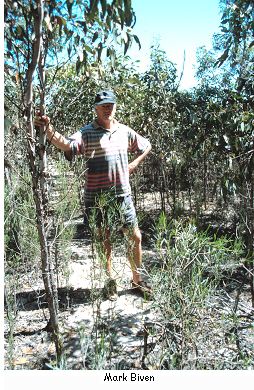
Mark and Jan Biven, 'Paningunya', Beaumont

|
Wetland protection
Mark and Jan Biven, 'Paningunya', Beaumont |
 |
 Background
Background
Mark and Jan Biven have lived on their farm for 20 years. They were the original settlers and began developing the farm for stock and crops in 1978. When they moved in Mark described the landscape. "All you could see for miles were trees and when the bulldozer contractors came there was no way they wanted to go around one thing. We had to carve it out anyway to get to our boundary because we were the first ones in here. So we had to clear outside the boundary to find our boundary line. So it was pretty hard to clear our boundary and leave a strip of trees and then start again so they just cleared it all. But we didn't know as much as we should have. The clearing was almost inevitable in a way, the blade plough was this great new invention that came in and took out the roots and all, what a devastating machine. At the time there was nothing on landcare, there was nothing even thought of. There were no maps available really that showed watercourses, although we did leave the odd one. Trees and mallee roots became the public enemy; you just hated them so much because that's what you were fighting to clear your land. One of the yate swamps was cleared by mistake. It would be really interesting to do the same thing again with the knowledge we've got now". Mark is pleased that he has got bush growing all around the property. He negotiated with his neighbour for him to leave some bush and Mark paid for the fence. The average annual rainfall is 450 millimetres with extremes as low as 250 mm. and as high as 600 mm. There is always rain in November during harvest and other summer rain. The property has numerous wetlands that at times are populated by hundreds of waterbirds. Mark, along with some of the other landholders in the district, was instrumental in getting the initial momentum happening with the Beaumont Better Farming Group. The group began planting trees and fencing off remnant vegetation in 1989. The Problem The Bivens have found that most of their problems occur from winter rainfall rather than summer rainfall. Winter rain causes the soil profile to become saturated and it gets too wet. "We've got a very shallow soil profile, which is clay, so as the crop grows it just gets waterlogged and eventually [water] has just got to spill out. In 1989 flood water stayed around in the wetlands for two years, then more came in 1992 and 1999". The Solution To protect the wetlands and also to try and alleviate some of the waterlogging problems the Bivens have been fencing off wetlands and planting trees since 1989.
They have also been carrying out trials around other wetlands. "We've been experimenting with direct seeding saltbush, a mix of trees with saltbush, all trees and all saltbush. We've also been putting in salt tolerant melaleucas and casuarinas and we've got a timber lot that has gone in over the years (yate, red river gum, sugar gum, brown mallet). We have got room for more there too and will be putting more in". "We've fenced 17 lakes off in 1300 acres and we now seem to have done most of the depressions around the farm and are really now needing to do fencelines of trees and corridors. The things you don't get any grants for". Mark prepares the tree lines by ripping a year in advance and says that, "If you do preparation the year before there should be enough moisture. But if you try and do it that year and it dries out they don't grow as well. Rip it up then push the soil back in so its firm and then you get a moisture bank. As long as your preparation is good and there's some good rain they seem to hang on. We wouldn't have watered the trees since 1991, the ones in the driveway that is. We have a 95% strike with planting unless we get grasshoppers through or a hail storm". The trees are planted using a hand planter and the saltbush is pushed into a hole poked in the soil. Using this method about a thousand plants can be put in during a morning. The trees are planted in July and Mark has found that he can't do it earlier because of the weeds. Mark believes that a lot of the success of revegetation depends on weed control, especially wire weed. He tries to spray them twice before any tree planting is done. "If you put them in too early you can get overrun with weeds, even wireweed, so it's best to put them in later, as long as there's moisture in the ground". The Outcomes and observations Mark and Jan are thrilled with the natural regeneration of yates and other species after fencing and flooding. "After a flood the natural regeneration occurs in huge numbers and as the water recedes there's no weeds. It virtually kills all the weed seeds and then the trees get a chance. What happened in this first swamp over here was absolutely spectacular. You can hardly walk through that one (photo above left). It was so easy, one fence was all it took. It's a pretty simple way to do things as long as you haven't got rye grass in there and weeds". Mark has found that planting seedlings has worked the best in his revegetation areas. He also found that bare rooted saltbush was really good but it is not available any more. The Biven's are also using farming methods that use up more water such as no till, growing better crops, planting perennials and saltbush. "Basically where our water falls it's held and we're trying to get methods in place to suck it out. Where the trees etc. have been planted the water doesn't sit around for so long. As long as you establish the trees before the salt gets in. That's what we've tried to achieve with the yates but you've got to be quick". Mark has found a problem with fencing off the wetlands in that the sheep walk around close to the fences on the corners and cause erosion problems. He also finds that using a boom spray for weed control is more difficult when the paddocks are carved up with fences, trees and lakes. Mark says that he would have started planting earlier if he had to start again and he would also have carried out better weed control. "If I'd known what I know now I would have started earlier. I used to put it off because I didn't think it was going to happen and it's inevitable. Just fence and tree off low-lying areas and recognise that it's the recharge areas that you've got to tree up. We ignore some of those areas a bit because they don't really hold water that often, but they should be planted". "We're pretty happy with what we've done. I think just concentrate on the hotspots and when you've done the hotspots you go and do your tree lines. I can always put some more trees in but its just making that effort now with sheep as they are and crops as they are, its effort and money, and priorities change. Putting the trees in is easy, it's just the effort to do the fencing". |
 |
|
 |
|
 |
|
 |